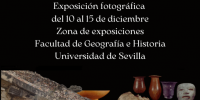La Pena de los Enamorados, a limestone massif located in Antequera, Spain, is a famous landmark since (at least) the Middle Ages on account of its marked anthropomorphic silhouette and geographic position right at the crossroads of Andalucía’s two main communication routes (connecting Malaga ´ and Cordoba, ´ in a South-North direction, and Sevilla and Granada in a West-East direction). In the last fifteen years, archaeological research has revealed substantial evidence of intense Late Neolithic, Copper Age and Early Bronze Age activity (spanning from the mid-4th to the early 2nd millennia BC) on its northern sector. This includes various loci of activity: (i) the Matacabras shelter, with schematic-style rock art, which is located at the foot of Tajo Colorado, a 100 m-high rocky wall that forms the mountain’s ‘chin’; (ii) the recently discovered Piedras Blancas megalithic grave; (iii) and several remains of activity, including Locus 4, on the steep glacis at the foot of Tajo Colorado. In this paper, we examine the acoustic behaviour of Tajo Colorado, Matacabras and Locus 4. Signals produced by means of a blank-shot pistol were recorded at each reception point by means of a high-quality audio recorder via a microphone condenser mic while controlling background noise levels. The study included impulse response analysis based on its temporal and frequency behaviour, through Schroeder decay curves, Envelop-Time Curves, spectrograms and spectrum curves. The results show good acoustic conditions, not unlike some ancient theatres, which reinforces the interpretation of the area as a major Neolithic open-air sanctuary.



